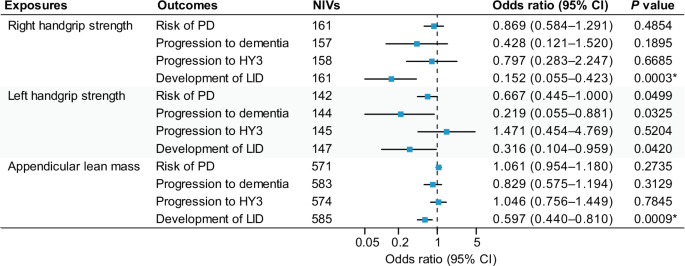通过孟德尔随机化探索肌肉疏松症对帕金森病风险和进展的因果效应
摘要
以往的观察性研究表明,肌肉疏松症与帕金森病(PD)有关,但这种关联是否是因果关系尚不清楚。本研究的目的是采用孟德尔随机化(MR)方法,研究肌肉疏松症相关特征与帕金森病风险或进展之间的因果关系。为评估因果关系,研究人员进行了双样本双向 MR 分析。从 IEU OpenGWAS 数据库中检索了与肌肉疏松症相关的特征的全基因组关联研究(GWAS)汇总统计数据,包括右手握力(n = 461,089 )、左手握力(n = 461,026 )和肢体瘦体重(n = 450,243 )。PD风险的GWAS数据来自FinnGen数据库(4235例病例;373,042例对照)。关于帕金森氏症进展(包括进展到 Hoehn 和 Yahr 3 期、进展到痴呆以及发展为左旋多巴诱发的运动障碍)的摘要级数据来自最近发表的一篇关于帕金森氏症进展的 GWAS 论文,该论文涉及来自 12 个纵向队列的 4093 名帕金森氏症患者。通过基于多基因评分(PGS)的方法和利用帕金森病进展标志物倡议(Parkinson's Progression Markers Initiative)的基因型数据进行的通路富集分析,对 MR 分析中发现的重要因果关系进行了验证。MR 结果表明,右手握力(几率比 [OR] = 0.152,95% 置信区间 [CI] = 0.055-0.423,调整后 P = 0.0036)和阑尾瘦肉率(OR = 0.597,95% CI = 0.440-0.810,调整后 P = 0.0111)对左旋多巴诱发的运动障碍的发生具有显著的因果关系。在Cox比例危险分析中,在调整协变量后,右手握力(危险比[HR] = 0.225,95% CI = 0.095-0.530,调整后P = 0.0019)和左手握力(HR = 0.303,95% CI = 0.121-0.59,调整后P = 0.0323)的PGS越高,左旋多巴诱发运动障碍的发病风险越低。通路富集分析表明,右手握力的全基因组重要单核苷酸多态性大量富集于控制突触可塑性的生物通路中。这项研究提供了遗传学证据,证明手握强度或附肢瘦肉对左旋多巴诱发的帕金森病运动障碍的发生具有保护作用。与肌肉疏松症相关的特征可能是左旋多巴诱发运动障碍的预后标记,也是预防左旋多巴诱发运动障碍的潜在治疗目标。

Previous observational studies suggested that sarcopenia is associated with Parkinson disease (PD), but it is unclear whether this association is causal. The objective of this study was to examine causal associations between sarcopenia-related traits and the risk or progression of PD using a Mendelian randomization (MR) approach. Two-sample bidirectional MR analyses were conducted to evaluate causal relationships. Genome-wide association study (GWAS) summary statistics for sarcopenia-related traits, including right handgrip strength (n = 461,089), left handgrip strength (n = 461,026), and appendicular lean mass (n = 450,243), were retrieved from the IEU OpenGWAS database. GWAS data for the risk of PD were derived from the FinnGen database (4235 cases; 373,042 controls). Summary-level data for progression of PD, including progression to Hoehn and Yahr stage 3, progression to dementia, and development of levodopa-induced dyskinesia, were obtained from a recent GWAS publication on progression of PD in 4093 patients from 12 longitudinal cohorts. Significant causal associations identified in MR analysis were verified through a polygenic score (PGS)-based approach and pathway enrichment analysis using genotype data from the Parkinson’s Progression Markers Initiative. MR results supported a significant causal influence of right handgrip strength (odds ratio [OR] = 0.152, 95% confidence interval [CI] = 0.055–0.423, adjusted P = 0.0036) and appendicular lean mass (OR = 0.597, 95% CI = 0.440–0.810, adjusted P = 0.0111) on development of levodopa-induced dyskinesia. In Cox proportional hazard analysis, higher PGSs for right handgrip strength (hazard ratio [HR] = 0.225, 95% CI = 0.095–0.530, adjusted P = 0.0019) and left handgrip strength (HR = 0.303, 95% CI = 0.121–0.59, adjusted P = 0.0323) were significantly associated with a lower risk of developing levodopa-induced dyskinesia, after adjusting for covariates. Pathway enrichment analysis revealed that genome-wide significant single-nucleotide polymorphisms for right handgrip strength were substantially enriched in biological pathways involved in the control of synaptic plasticity. This study provides genetic evidence of the protective role of handgrip strength or appendicular lean mass on the development of levodopa-induced dyskinesia in PD. Sarcopenia-related traits can be promising prognostic markers for levodopa-induced dyskinesia and potential therapeutic targets for preventing levodopa-induced dyskinesia in patients with PD.

 求助内容:
求助内容: 应助结果提醒方式:
应助结果提醒方式:


